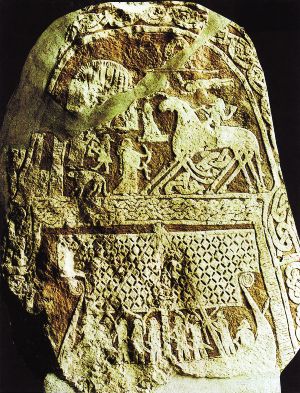Sleipnir
Text by Hallfridur J. Ragnheidardottir
With permission from The Archive for Research in Archetypal Symbolism (ARAS)
www.aras.org. Copyright ARAS.

Galloping forth on his eight legs, Sleipnir brings Óðinn home to Valhalla, the god’s celestial abode and paradise of slain warriors, where a valkyrie offers a ritual horn of mead to the arrival. The cup in Óðinn’s hand and the spear hovering above him reflect his dual nature as poet and god of war.
“Who is that man in a gold helmet who rides through air and sea,” asks the giant Hrungnir as Óðinn darts into giant-land on his gray eight-legged Sleipnir. Sleipnir’s striking number of legs suggests swiftness while the winding, serpent-like phallus echoes his weaving in and out of worlds in unison with his master, entwining the conscious and the unconscious into a unified pattern. His name indicates a slippery nature which accords with Óðinn’s slyness in his commerce with the powers of the underworld. Like the Roman god Mercury, with whom he was frequently identified, Óðinn is a master of magic, wisdom and the word; he is the patron of poets. In his gold helmet he is the symbol of the sun that courses along its celestial path and dives into the shadowy realm below; he is the solar hero’s inspiration.
Sleipnir came into being when the æsir (Óðinn and his pantheon) were on the brink of being engulfed by sterility and darkness due to their effort to isolate themselves from their antagonists, the giants. They had hired a rock-giant to build a wall around their utopian city, Ásgarðr, and promised him Freyja, goddess of love and fertility, and the sun and the moon as well, if the wall be completed before the first day of summer. They never believed that it would and heedlessly agreed to let the builder use his horse, Svaðilfari, whose miraculous output drove them to deceit: the trickster Loki assumed the shape of a mare and lured Svaðilfari away from his master into the woods. Of their union was born the gray eight-legged colt, a cross between light and darkness.
It was said of Sleipnir that his teeth were inscribed with runes, and the runes were keys to the mysteries of creation. He knew his way down to Niflhel, the deepest and darkest of worlds, where neither the bloodthirsty hel-hound nor Hel’s towering gate deterred him from leaping with his master into the beyond. His mediating function is reflected in the name of the world tree, Yggdrasill (Óðinn’s horse), on which Óðinn hung in self-sacrifice to attain runic wisdom. The runes had an indwelling power to heal, and the eight-legged horse is the typical steed of a shaman, (Davidson, 142), but evidence of Óðinn in the role of a witch-doctor is scarce in comparison with his more prominent reputation as an inciter of war and strife.
The betrayal attached to Sleipnir’s birth was a seed that contained the doom of a corrupt order. (Nordal, 194) At ragnarök, the apocalyptic end of the world, when he carries Óðinn in a gold helmet to his last war, Sleipnir’s function as an agent of transformation reaches culmination, for from the depths earth rises virgin anew.
In a gray water spirit of legend, believed to lure people to mount it and jump with them into lakes and pits, we espy Sleipnir’s ghost summoning us to take heart and make the leap of faith.
Briem, Ólafur, ed. “Hávamál.” Eddu kvæði, I. Reykjavík, 1985.
Briem, Ólafur, ed. “Baldurs draumar & Sigurdrífumál.” Eddu kvæði, II. Reykjavík, 1985.
Davidson, H.R.Ellis. Gods and Myths of Northern Europe. Penguin Books, 1990.
Nordal, Sigurður. Völuspá. Reykjavík, 1952.
Simek, Rudolf. Dictionary of Northern Mythology. Transl. from German by Hall, Angela. Stuttgart, 1993.
Sturluson, Snorri. Edda. Ed. Jónsson, Guðni. Reykjavík, 1935.
